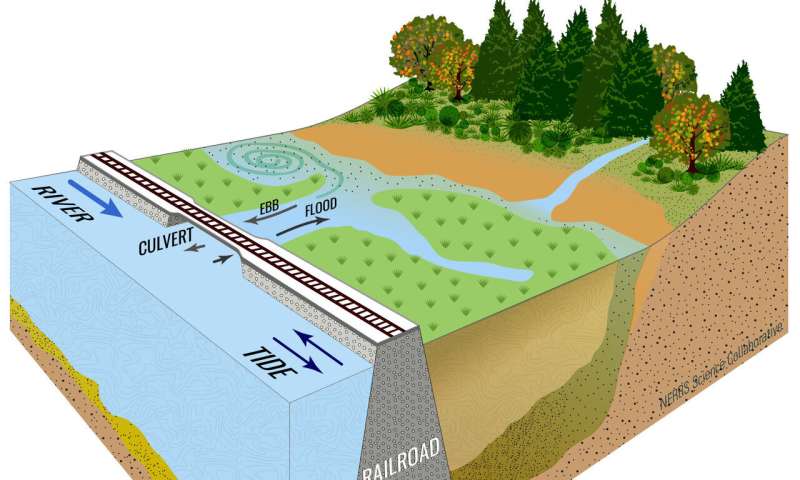More than half of Hudson River tidal marshes were created accidentally by humans

In a new study of tidal marsh resilience to sea level rise, geologist and first author Brian Yellen at the University of Massachusetts Amherst and colleagues observed that Hudson River Estuary marshes are growing upward at a rate two to three times faster than sea level rise, "suggesting that they should be resilient to accelerated sea level rise in the future," he says.
Writing in Earth Surface Processes and Landforms, Yellen and colleagues documented that more than half of Hudson River tidal marshes formed since 1850. That year, the channel was straightened and a riverside railroad, berms, jetties and human-made islands of dredged soil were built. This all trapped sediment and created backwaters that often—but not always—turned into marshes, an "unintended result of early industrial development," they state.
"In one case, historical aerial photos document this transition occurring in less than 18 years, offering a timeframe for marsh development," they point out. Yellen's co-authors are colleagues Jonathan Woodruff, Caroline Ladlow and undergraduate Waverly Lau at UMass Amherst, plus Sarah Fernald at New York's department of environmental conservation and David K. Ralston of Woods Hole Oceanographic Institution.
Yellen notes that for this "very collaborative" study, the researchers took advantage of "an experiment that has already happened over decades or centuries. Many of these accidental tidal marshes worked; they protect the shoreline and provide one of the richest ecosystems in terms of direct ecological and human benefits."
Further, marshes are "really useful," he adds—as a first line of defense against coastal flooding, essential habitat for juvenile commercial fish species, they store huge amounts of carbon that mitigates climate change, they provide habitat for migratory birds, filter nutrients coming off the land "and they're beautiful."
Yellen and colleagues write that these tidal wetlands "currently trap roughly 6% of the Hudson River's sediment load. Results indicate that when sediment is readily available, freshwater tidal wetlands can develop relatively rapidly in sheltered settings. The study sites serve as useful examples to help guide future tidal marsh creation and restoration efforts."
Their research involved seven sites spanning more than 100 miles of the Hudson Estuary, "from Wall Street up to Albany," Yellen says. The bays where tidal marshes developed started out six to seven feet deep and have steadily grown vertically. "One concern for marshes globally is that they will be drowned by rising sea level, but this case study shows how marshes can be created and it gave us some timing benchmarks for what is considered a tricky ecosystem restoration," he adds.
The researchers used two main methods to investigate the river's history and resilience in the face of sea level rise—sediment cores that shed light on how fast sediment accumulated and historical maps, charts and aerial photos to determine how the sites have changed over time.Yellen summarizes, "As long as there is space for sediment to accumulate, new marshes can develop. There is a community of land trusts up and down the river who are planning now for future sea level rise and considering where new marshes can form. This research will help them and state agencies guide land acquisition and land conservation strategies adjacent to the river to 2100 and beyond."
The research, part of the Dams and Sediment in the Hudson (DaSH) project, was supported by a grant to Ralston from NOAA's National Estuarine Research Reserve Collaborative, plus the U.S. Geological Survey and the Department of Interior Northeast Climate Adaptation Science Center at UMass Amherst.
Also, Lau received a Polgar Fellowship from the Hudson River Foundation for her senior thesis project. She took the lead on one of the sites and made a short film about tidal marshes around the world and the Hudson River marsh near her home in Queens.
More information: Brian Yellen et al, Rapid Tidal Marsh Development in Anthropogenic Backwaters, Earth Surface Processes and Landforms (2020). DOI: 10.1002/esp.5045
Provided by University of Massachusetts Amherst





















